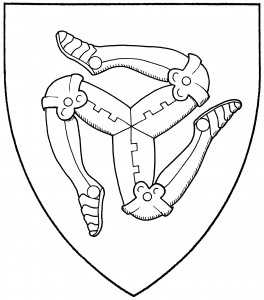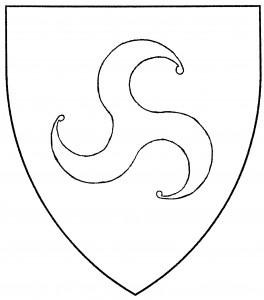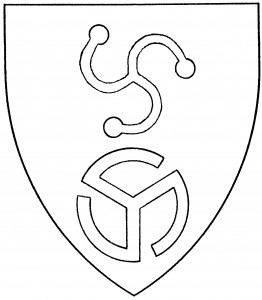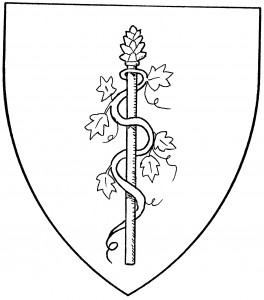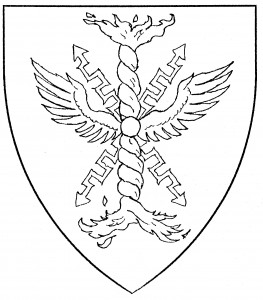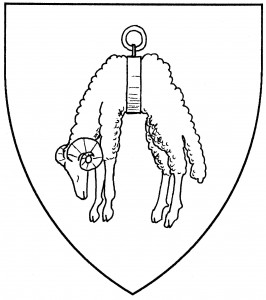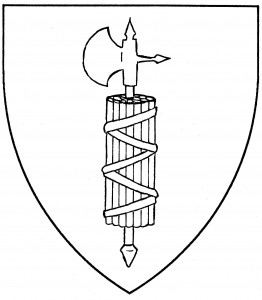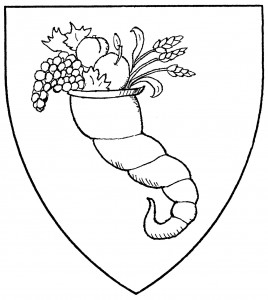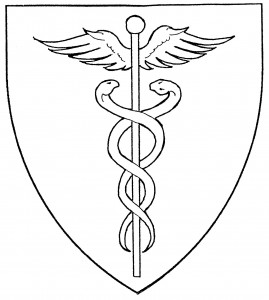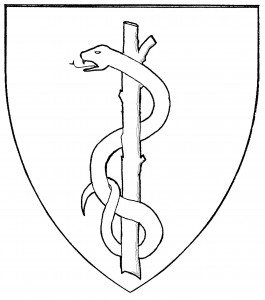A triskelion is a design first used in classical Greek art, with three embowed limbs conjoined in pall. The name derives from the Greek tri, skelos, “three legs”; the classical form does indeed use three bent legs, conjoined at the thighs. However, mundane armory doesn’t tend to use this term in blazon; most instances of triskelions are blazoned as “three arms” or “three legs” conjoined, and listed as such in mundane ordinaries. (The illustration shows the legs in armor, as in the arms of the Kings of the Isle of Man, c.1275 [ANA2 478].)
In Society heraldry, the most common form of triskelion is the “triskelion arrondi” or “triskele”: three pointed limbs, smoothly curved, and embowed. (The embowment is part of the definition of a triskelion; without it, the design would simply be three charges conjoined in pall.). With no examples from period armory, the triskelion arrondi is deemed a step from period practice.
Some of the Society’s triskelions are based on certain crosses. Thus we have the “triskelion pommetty” and the “triskelion gammadion in annulo”. (The latter form, having been adopted by certain white supremacist groups, is no longer registerable.) Presumably, one could have a “triskelion fleury” as well, or some other triskelion based on a variant of cross.
Triskelions may also be made up of other charges, so long as they are bent or embowed. Thus there might be a “triskelion of dragon’s heads”, a “triskelion of three scarves”, or a “triskelion of chevrons”. One example of this type, the “triskelion of spirals”, has been deemed a step from period practice, but still permitted.
Similar to the triskelion is the “pentaskelion” which, as its name implies, has five limbs instead of three.
Triskelions may turn either clockwise or counter-clockwise; the fact is not blazoned. The most famous mundane triskelion, in the arms of the Isle of Man, has been depicted in period art going either direction; and the same is true of triskeles in Society heraldry. It is left to the artist’s license, and no difference is counted for it. For related charges, see arm, cross, leg, pall.
The King of Trimaris bears: Argent, on a fess wavy between two triskeles azure a crown of five points, each point tipped with a mullet argent, between overall a laurel wreath counterchanged.
Finngall McKetterick bears: Or, a triskelion of armored human legs vert.
Douglas Longshanks bears: Sable, a pentaskelion of armored legs argent.
Terryl of Talavera bears: Argent, a triskelion arrondi azure, between in pale two torteaux.
Sorcha ar Menez bears: Vert, a triskelion of spirals argent between in cross four mullets pierced Or.
Colm the Defrocked bears: Vert, a triskelion of demi-birds argent.
Goraidh Ailean na Gordanaich bears: Purpure, a triskelion pommetty pallwise Or.
